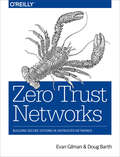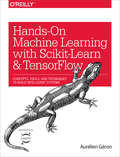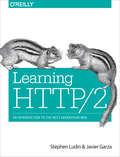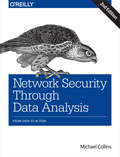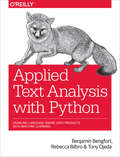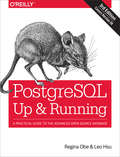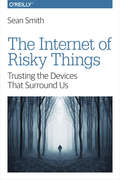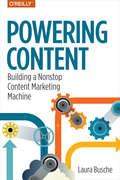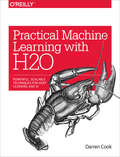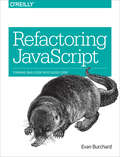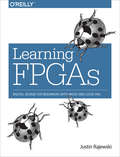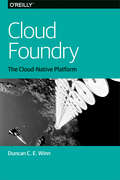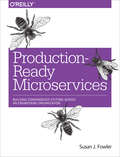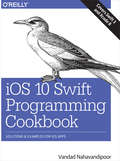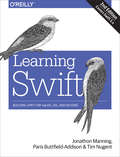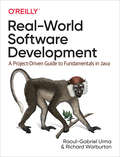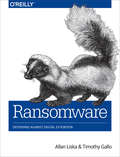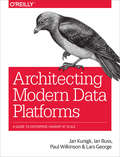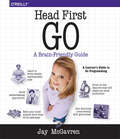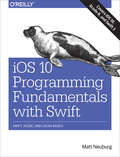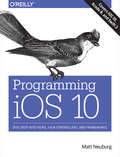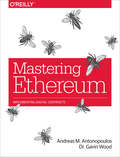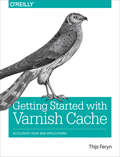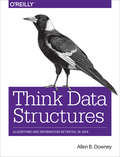- Table View
- List View
Zero Trust Networks: Building Secure Systems in Untrusted Networks
by Doug Barth Evan GilmanThe perimeter defenses guarding your network perhaps are not as secure as you think. Hosts behind the firewall have no defenses of their own, so when a host in the "trusted" zone is breached, access to your data center is not far behind. That’s an all-too-familiar scenario today. With this practical book, you’ll learn the principles behind zero trust architecture, along with details necessary to implement it.The Zero Trust Model treats all hosts as if they’re internet-facing, and considers the entire network to be compromised and hostile. By taking this approach, you’ll focus on building strong authentication, authorization, and encryption throughout, while providing compartmentalized access and better operational agility.Understand how perimeter-based defenses have evolved to become the broken model we use todayExplore two case studies of zero trust in production networks on the client side (Google) and on the server side (PagerDuty)Get example configuration for open source tools that you can use to build a zero trust networkLearn how to migrate from a perimeter-based network to a zero trust network in production
Hands-On Machine Learning with Scikit-Learn and TensorFlow: Concepts, Tools, and Techniques to Build Intelligent Systems
by Aurélien GéronGraphics in this book are printed in black and white.Through a series of recent breakthroughs, deep learning has boosted the entire field of machine learning. Now, even programmers who know close to nothing about this technology can use simple, efficient tools to implement programs capable of learning from data. This practical book shows you how.By using concrete examples, minimal theory, and two production-ready Python frameworks—scikit-learn and TensorFlow—author Aurélien Géron helps you gain an intuitive understanding of the concepts and tools for building intelligent systems. You’ll learn a range of techniques, starting with simple linear regression and progressing to deep neural networks. With exercises in each chapter to help you apply what you’ve learned, all you need is programming experience to get started. Explore the machine learning landscape, particularly neural nets; Use scikit-learn to track an example machine-learning project end-to-end; Explore several training models, including support vector machines, decision trees, random forests, and ensemble methods; Use the Tensor; Flow library to build and train neural nets; Dive into neural net architectures, including convolutional nets, recurrent nets, and deep reinforcement learning; Learn techniques for training and scaling deep neural nets; and apply practical code examples without acquiring excessive machine learning theory or algorithm details.
Learning HTTP/2: A Practical Guide for Beginners
by Javier Garza Stephen LudinWhat can your organization gain by adopting HTTP/2? How about faster, simpler, and more robust websites and applications? This practical guide demonstrates how the latest version of the Hypertext Transfer Protocol can dramatically improve website and application performance. You’ll take a deep dive into HTTP/2 details, and learn how this updated protocol is changing the web landscape.HTTP/1.1 has been the primary means of communicating data across the web for the past 20 years, but the level of interaction today has gone well beyond what people envisioned in 1997. With this book, authors Stephen Ludin and Javier Garza show you how HTTP/2 will help speed the execution of modern sites and applications.With this book, you’ll explore:Performance challenges that led to the HTTP upgradeHTTP/2 in a nutshell, including benefits and transition methodsExisting best practices and hacks to improve web performanceHTTP/2 support for browsers, servers, proxies, and content delivery networksHow the performance of sites using HTTP/2 compares to their HTTP/1.1 experienceHTTP/2’s effect on specific issues such as latency, packet loss, and Time to First Byte (TTFB)HTTP/2’s effect on specific issues such as latency, packet loss, and Time to First Byte (TTFB)
Network Security Through Data Analysis: From Data to Action
by Michael CollinsTraditional intrusion detection and logfile analysis are no longer enough to protect today’s complex networks. In the updated second edition of this practical guide, security researcher Michael Collins shows InfoSec personnel the latest techniques and tools for collecting and analyzing network traffic datasets. You’ll understand how your network is used, and what actions are necessary to harden and defend the systems within it.In three sections, this book examines the process of collecting and organizing data, various tools for analysis, and several different analytic scenarios and techniques. New chapters focus on active monitoring and traffic manipulation, insider threat detection, data mining, regression and machine learning, and other topics.You’ll learn how to:Use sensors to collect network, service, host, and active domain dataWork with the SiLK toolset, Python, and other tools and techniques for manipulating data you collectDetect unusual phenomena through exploratory data analysis (EDA), using visualization and mathematical techniquesAnalyze text data, traffic behavior, and communications mistakesIdentify significant structures in your network with graph analysisExamine insider threat data and acquire threat intelligenceMap your network and identify significant hosts within itWork with operations to develop defenses and analysis techniques
Applied Text Analysis with Python: Enabling Language-Aware Data Products with Machine Learning
by Benjamin Bengfort Rebecca Bilbro Tony OjedaFrom news and speeches to informal chatter on social media, natural language is one of the richest and most underutilized sources of data. Not only does it come in a constant stream, always changing and adapting in context; it also contains information that is not conveyed by traditional data sources. The key to unlocking natural language is through the creative application of text analytics. This practical book presents a data scientist’s approach to building language-aware products with applied machine learning.You’ll learn robust, repeatable, and scalable techniques for text analysis with Python, including contextual and linguistic feature engineering, vectorization, classification, topic modeling, entity resolution, graph analysis, and visual steering. By the end of the book, you’ll be equipped with practical methods to solve any number of complex real-world problems.Preprocess and vectorize text into high-dimensional feature representationsPerform document classification and topic modelingSteer the model selection process with visual diagnosticsExtract key phrases, named entities, and graph structures to reason about data in textBuild a dialog framework to enable chatbots and language-driven interactionUse Spark to scale processing power and neural networks to scale model complexity
PostgreSQL: A Practical Guide to the Advanced Open Source Database
by Regina O. Obe Leo S. HsuThinking of migrating to PostgreSQL? This clear, fast-paced introduction helps you understand and use this open source database system. Not only will you learn about the enterprise class features in versions 9.5 to 10, you’ll also discover that PostgeSQL is more than a database system—it’s an impressive application platform as well.With examples throughout, this book shows you how to achieve tasks that are difficult or impossible in other databases. This third edition covers new features, such as ANSI-SQL constructs found only in proprietary databases until now: foreign data wrapper (FDW) enhancements; new full text functions and operator syntax introduced in version 9.6; XML constructs new in version 10; query parallelization features introduced in 9.6 and enhanced in 10; built-in logical replication introduced in Version 10.e.If you’re a current PostgreSQL user, you’ll pick up gems you may have missed before.Learn basic administration tasks such as role management, database creation, backup, and restoreApply the psql command-line utility and the pgAdmin graphical administration toolExplore PostgreSQL tables, constraints, and indexesLearn powerful SQL constructs not generally found in other databasesUse several different languages to write database functionsTune your queries to run as fast as your hardware will allowQuery external and variegated data sources with foreign data wrappersLearn how to use built-in replication to replicate data
The Internet of Risky Things: Trusting the Devices That Surround Us
by Sean SmithBy 2020, the Internet of Things (IoT) will consist of millions of computational devices intimately connected to real-world aspects of human life. In this insightful book, Professor Sean Smith, who worked in information security long before the web appeared, explains that if we build the IoT the way we built the current internet and other information technology initiatives, we’re headed for trouble.With a focus on concrete solutions, The Internet of Risky Things explains how we can avoid simple flaws that have plagued several dramatic IT advances in recent decades. Developers, engineers, industrial designers, makers, and researchers will explore "design patterns of insecurities" and learn what’s required to route around or fix them in the nascent IoT.Examine bugs that plague large-scale systems, including integer overflow, race conditions, and memory corruptionLook at successful and disastrous examples of previous quantum leaps in health IT, the smart grid, and autonomous vehiclesExplore patterns in coding, authentication, and cryptography that led to insecurityLearn how blunders that led to spectacular IT disasters could have been avoided
Powering Content: Building a Nonstop Content Marketing Machine
by Laura BuscheYour new product is ready to launch and you’re itching to tell potential customers all about it. But how do you make your message stand out above all the noise and marketing clutter? Take the guesswork out of content management with this hands-on guide. You’ll learn how to produce and manage powerful content pieces that speak directly to customers and compel them to respond.Author Laura Busche walks you through content strategies and tactics drawn from business, design, and psychology insights. Packed with examples and exercises, this book teaches you how to tell your story with engaging copy, potent images, and striking design—all carefully orchestrated through well-oiled production management. Solopreneurs, startups, marketing managers, and execs will learn 10 Essential Steps to Content Success, with deep dives into:Content strategy: understand your audience, choose and prioritize channels, and find your brand’s core themes, voice, and toneContent creation: craft an engaging experience with content formats and copywriting formulas and templatesContent management: organize, delegate, and supervise tasks; optimize the content production process to reuse successful patterns
Practical Machine Learning with H2O: Powerful, Scalable Techniques for Deep Learning and AI
by Darren Cookthis is a test paragraph.this is the second test paragraph.
Refactoring JavaScript: Turning Bad Code Into Good Code
by Evan BurchardHow often do you hear people say things like this? "Our JavaScript is a mess, but we’re thinking about using [framework of the month]."Like it or not, JavaScript is not going away. No matter what framework or ”compiles-to-js” language or library you use, bugs and performance concerns will always be an issue if the underlying quality of your JavaScript is poor. Rewrites, including porting to the framework of the month, are terribly expensive and unpredictable. The bugs won’t magically go away, and can happily reproduce themselves in a new context. To complicate things further, features will get dropped, at least temporarily.The other popular method of fixing your JS is playing “JavaScript Jenga,” where each developer slowly and carefully takes their best guess at how the out-of-control system can be altered to allow for new features, hoping that this doesn’t bring the whole stack of blocks down. This book provides clear guidance on how best to avoid these pathological approaches to writing JavaScript:Recognize you have a problem with your JavaScript quality.Forgive the code you have now, and the developers who made it.Learn repeatable, memorable, and time-saving refactoring techniques.Apply these techniques as you work, fixing things along the way.Internalize these techniques, and avoid writing as much problematic code to begin with.Bad code doesn’t have to stay that way. And making it better doesn’t have to be intimidating or unreasonably expensive.
Learning FPGAs: Digital Design for Beginners with Mojo and Lucid HDL
by Justin RajewskiLearn how to design digital circuits with FPGAs (field-programmable gate arrays), the devices that reconfigure themselves to become the very hardware circuits you set out to program. With this practical guide, author Justin Rajewski shows you hands-on how to create FPGA projects, whether you’re a programmer, engineer, product designer, or maker. You’ll quickly go from the basics to designing your own processor.Designing digital circuits used to be a long and costly endeavor that only big companies could pursue. FPGAs make the process much easier, and now they’re affordable enough even for hobbyists. If you’re familiar with electricity and basic electrical components, this book starts simply and progresses through increasingly complex projects.Set up your environment by installing Xilinx ISE and the author’s Mojo IDELearn how hardware designs are broken into modules, comparable to functions in a software programCreate digital hardware designs and learn the basics on how they’ll be implemented by the FPGABuild your projects with Lucid, a beginner-friendly hardware description language, based on Verilog, with syntax similar to C/C++ and Java
Cloud Foundry: The Cloud-Native Platform
by Duncan C. E. WinnWhat exactly is a cloud-native platform? It's certainly a hot topic in IT, as enterprises today assess this option for developing and delivering software quickly and repeatedly. This O'Reilly report explains the capabilities of cloud-native platforms and examines the fundamental changes enterprises need to make in process, organization, and culture if they're to take real advantage of this approach.Author Duncan Winn focuses on the open source platform Cloud Foundry, one of the more prominent cloud-native providers. You'll learn how cloud-native applications are designed to be "infrastructure unaware" so they can thrive and move at will in the highly distributed and constantly evolving cloud environment.With this report, you'll explore:Technical driving forces that are rapidly changing the way organizations develop and deliver software todayHow key concepts underpinning the Cloud Foundry platform leverage each of the technical forces discussedHow cloud-native platforms remove the requirement to perform undifferentiated heavy lifting, such as provisioning VMs, middleware, and databasesWhy cloud-native platforms enable fast feedback loops as you move from agile development to agile deploymentRecommended changes and practical considerations for organizations that want to build cloud-native applications
Production-Ready Microservices: Building Standardized Systems Across an Engineering Organization
by Susan J. FowlerOne of the biggest challenges for organizations that have adopted microservice architecture is the lack of architectural, operational, and organizational standardization. After splitting a monolithic application or building a microservice ecosystem from scratch, many engineers are left wondering what's next. In this practical book, author Susan Fowler presents a set of microservice standards in depth, drawing from her experience standardizing over a thousand microservices at Uber. You'll learn how to design microservices that are stable, reliable, scalable, fault tolerant, performant, monitored, documented, and prepared for any catastrophe.Explore production-readiness standards, including:Stability and Reliability: develop, deploy, introduce, and deprecate microservices; protect against dependency failuresScalability and Performance: learn essential components for achieving greater microservice efficiencyFault Tolerance and Catastrophe Preparedness: ensure availability by actively pushing microservices to fail in real timeMonitoring: learn how to monitor, log, and display key metrics; establish alerting and on-call proceduresDocumentation and Understanding: mitigate tradeoffs that come with microservice adoption, including organizational sprawl and technical debt
iOS 10 Swift Programming Cookbook: Solutions and Examples for iOS Apps
by Vandad NahavandipoorReady to build truly stunning apps for iPhone, iPad, and Apple Watch? This cookbook--written exclusively in Swift 3--provides more than 120 proven solutions for tackling the latest features in iOS 10 and watchOS 3. With these code-rich recipes, you'll learn how to build dynamic voice interfaces with Siri and messaging apps with iMessage. You'll also learn how to use interactive maps, multitasking functionality, the UI Testing framework, and many other features.This cookbook is ideal for intermediate and advanced iOS developers looking to work with the newest versions of Apple's mobile operating systems. Each recipe includes reusable code that's available on GitHub, so you can put it to work right away.Let users interact with your apps and services through SiriWrite your own iMessage extensions that allow added interactivityWork with features in Swift 3, Xcode 8, and Interface BuilderBuild standalone apps for Apple WatchCreate vibrant user interfaces with new UIKit featuresUse Spotlight APIs to make your app content searchableAdd Picture in Picture playback functionality to iPad appsTake advantage of MapKit and Core Location updatesUse Apple's new UI Testing frameworkLiven up your UI with gravity and turbulence fields
Learning Swift: Building Apps for macOS, iOS, and Beyond (2nd Edition)
by Jon Manning Paris Buttfield-Addison Tim NugentGet valuable hands-on experience with Swift 3, the latest version of Apple’s programming language. With this practical guide, skilled programmers with little or no knowledge of Apple development will learn how to code with Swift 3 by developing three complete, tightly linked versions of the Notes application for the OS X, iOS, and watchOS platforms.In the process, you’ll learn Swift’s fundamentals, including its syntax and features, along with the basics of the Cocoa, CocoaTouch, and WatchKit frameworks. This book teaches you how to use common design patterns for Swift, how to structure an application for Apple’s platforms, and how to submit working apps to the App Store.Divided into four distinct parts, this book includes: Swift 2 basics: Learn Swift’s basic building blocks and features for object-oriented development; OS X app development: Set up the document model, build out features, and sync data with iCloud; iOS app development: Use multimedia, contacts, location, notifications, and iCloud files to build a fully featured iOS Notes app; Advanced app extensions: Build an Apple Watch app, and learn how to debug, monitor, and test all three of your Swift apps
Real-World Software Development: A Project-Driven Guide to Fundamentals in Java
by Raoul-Gabriel Urma Richard WarburtonExplore the latest Java-based software development techniques and methodologies through the project-based approach in this practical guide. Unlike books that use abstract examples and lots of theory, Real-World Software Development shows you how to develop several relevant projects while learning best practices along the way.With this engaging approach, junior developers capable of writing basic Java code will learn about state-of-the-art software development practices for building modern, robust and maintainable Java software. You’ll work with many different software development topics that are often excluded from software develop how-to references.Featuring real-world examples, this book teaches you techniques and methodologies for functional programming, automated testing, security, architecture, and distributed systems.
Ransomware: Defending Against Digital Extortion
by Timothy Gallo Allan LiskaThe biggest online threat to businesses and consumers today is ransomware, a category of malware that can encrypt your computer files until you pay a ransom to unlock them. With this practical book, you'll learn how easily ransomware infects your system and what steps you can take to stop the attack before it sets foot in the network.Security experts Allan Liska and Timothy Gallo explain how the success of these attacks has spawned not only several variants of ransomware, but also a litany of ever-changing ways they're delivered to targets. You'll learn pragmatic methods for responding quickly to a ransomware attack, as well as how to protect yourself from becoming infected in the first place.Learn how ransomware enters your system and encrypts your filesUnderstand why ransomware use has grown, especially in recent yearsExamine the organizations behind ransomware and the victims they targetLearn how wannabe hackers use Ransomware as a Service (RaaS) to launch campaignsUnderstand how ransom is paid--and the pros and cons of payingUse methods to protect your organization's workstations and servers
Architecting Modern Data Platforms: A Guide to Enterprise Hadoop at Scale
by Paul Wilkinson Lars George Jan Kunigk Ian BussThere’s a lot of information about big data technologies, but splicing these technologies into an end-to-end enterprise data platform is a daunting task not widely covered. With this practical book, you’ll learn how to build big data infrastructure both on-premises and in the cloud and successfully architect a modern data platform.Ideal for enterprise architects, IT managers, application architects, and data engineers, this book shows you how to overcome the many challenges that emerge during Hadoop projects. You’ll explore the vast landscape of tools available in the Hadoop and big data realm in a thorough technical primer before diving into:Infrastructure: Look at all component layers in a modern data platform, from the server to the data center, to establish a solid foundation for data in your enterprisePlatform: Understand aspects of deployment, operation, security, high availability, and disaster recovery, along with everything you need to know to integrate your platform with the rest of your enterprise ITTaking Hadoop to the cloud: Learn the important architectural aspects of running a big data platform in the cloud while maintaining enterprise security and high availability
Head First Go
by Jay McGavrenGo represents an attempt to improve on some weaknesses of traditional compiled programming languages. It de-emphasizes or removes error-prone language structures like class inheritance and exception handling. It features great concurrency support and automatic memory management (garbage collection).Existing Go books tend to be highly technical in nature, teaching all aspects of the language regardless of their relevance to beginners. This book, rather than talking about the features of Go in abstract terms, features simple, clear examples that demonstrate Go in action, and diagrams to explain difficult concepts.This book will not only teach developers basic language features, it will get them comfortable consulting error output, documentation, and search engines to find solutions to problems. It will teach all the conventions and techniques that employers expect an entry-level Go developer to know.
iOS 10 Programming Fundamentals with Swift: Swift, Xcode, and Cocoa Basics
by Matt NeuburgMove into iOS development by getting a firm grasp of its fundamentals, including the Xcode IDE, the Cocoa Touch framework, and Swift 3--the latest version of Apple's acclaimed programming language. With this thoroughly updated guide, you'll learn Swift's object-oriented concepts, understand how to use Apple's development tools, and discover how Cocoa provides the underlying functionality iOS apps need to have.Explore Swift's object-oriented concepts: variables and functions, scopes and namespaces, object types and instancesBecome familiar with built-in Swift types such as numbers, strings, ranges, tuples, Optionals, arrays, dictionaries, and setsLearn how to declare, instantiate, and customize Swift object types: enums, structs, and classesDiscover powerful Swift features such as protocols and genericsCatch up on Swift 3 innovations: revised APIs, new Foundation bridged types, and moreTour the lifecycle of an Xcode project from inception to App Store--including Xcode's new automatic code signing and debugging featuresConstruct app interfaces with the nib editor, Interface BuilderUnderstand Cocoa's event-driven model and its major design patterns and featuresFind out how Swift communicates with Cocoa's C and Objective-C APIsOnce you master the fundamentals, you'll be ready to tackle the details of iOS app development with author Matt Neuburg's companion guide, Programming iOS 10.
Programming iOS 10: Dive Deep into Views, View Controllers, and Frameworks
by Matt NeuburgIf you're grounded in the basics of Swift, Xcode, and the Cocoa framework, this book provides a structured explanation of all essential real-world iOS app components. Through deep exploration and copious code examples, you'll learn how to create views, manipulate view controllers, and add features from iOS frameworks.Stay up-to-date on iOS 10 innovations, such as property animators, force touch, speech recognition, and the User Notification framework, as well as Xcode 8 improvements for autolayout and asset catalogs. All example code (now rewritten in Swift 3) is available on GitHub for you to download, study, and run.Create, arrange, draw, layer, and animate views that respond to touchUse view controllers to manage multiple screens of interfaceMaster interface classes for scroll views, table views, text, popovers, split views, web views, and controlsDive into frameworks for sound, video, maps, and sensorsAccess user libraries: music, photos, contacts, and calendarExplore additional topics, including files, networking, and threadsWant to brush up on the basics? Pick up iOS 10 Programming Fundamentals with Swift (978-1-491-97007-2) to learn about Swift, Xcode, and Cocoa. Together with Programming iOS 10, you'll gain a solid, rigorous, and practical understanding of iOS 10 development.
Product Roadmaps Relaunched: How to Set Direction while Embracing Uncertainty
by C. Todd Lombardo Bruce Mccarthy Evan Ryan Michael ConnorsA good product roadmap is one of the most important and influential documents an organization can develop, publish, and continuously update. In fact, this one document can steer an entire organization when it comes to delivering on company strategy.This practical guide teaches you how to create an effective product roadmap, and demonstrates how to use the roadmap to align stakeholders and prioritize ideas and requests. With it, you’ll learn to communicate how your products will make your customers and organization successful.Whether you're a product manager, product owner, business analyst, program manager, project manager, scrum master, lead developer, designer, development manager, entrepreneur, or business owner, this book will show you how to:Articulate an inspiring vision and goals for your productPrioritize ruthlessly and scientificallyProtect against pursuing seemingly good ideas without evaluation and prioritizationEnsure alignment with stakeholdersInspire loyalty and over-delivery from your teamGet your sales team working with you instead of against youBring a user and buyer-centric approach to planning and decision-makingAnticipate opportunities and stay ahead of the gamePublish a comprehensive roadmap without overcommitting
Mastering Ethereum: Building Smart Contracts and DApps
by Andreas M. Antonopoulos Gavin WoodEthereum represents the gateway to a worldwide, decentralized computing paradigm. This platform enables you to run decentralized applications (DApps) and smart contracts that have no central points of failure or control, integrate with a payment network, and operate on an open blockchain. With this practical guide, Andreas M. Antonopoulos and Gavin Wood provide everything you need to know about building smart contracts and DApps on Ethereum and other virtual-machine blockchains.Discover why IBM, Microsoft, NASDAQ, and hundreds of other organizations are experimenting with Ethereum. This essential guide shows you how to develop the skills necessary to be an innovator in this growing and exciting new industry.Run an Ethereum client, create and transmit basic transactions, and program smart contractsLearn the essentials of public key cryptography, hashes, and digital signaturesUnderstand how "wallets" hold digital keys that control funds and smart contractsInteract with Ethereum clients programmatically using JavaScript libraries and Remote Procedure Call interfacesLearn security best practices, design patterns, and anti-patterns with real-world examplesCreate tokens that represent assets, shares, votes, or access control rightsBuild decentralized applications using multiple peer-to-peer (P2P) components
Getting Started with Varnish Cache: Accelerate Your Web Applications
by Thijs FerynHow long does it take for your website to load? Web performance is just as critical for small and medium-sized websites as it is for massive websites that receive tons of hits. Before you pour money and time into rewriting your code or replacing your infrastructure, first consider a reverse-caching proxy server like Varnish. With this practical book, you’ll learn how Varnish can give your website or API an immediate performance boost.Varnish mimicks the behavior of your webserver, caches its output in memory, and serves the result directly to clients without having to access your webserver. If you’re a web developer familiar with HTTP, this book helps you master Varnish basics, so you can get up and running in no time. You’ll learn how to use the Varnish Configuration Language and HTTP best practices to achieve faster performance and a higher hit rate.Understand how Varnish helps you gain optimum web performanceUse HTTP to improve the cache-ability of your websites, web applications, and APIsProperly invalidate your cache when the origin data changesOptimize access to your backend serversAvoid common mistakes when using Varnish in the wildUse logging and debugging tools to examine the behavior of Varnish
Think Data Structures: Algorithms and Information Retrieval in Java
by Allen B. DowneyIf you’re a student studying computer science or a software developer preparing for technical interviews, this practical book will help you learn and review some of the most important ideas in software engineering—data structures and algorithms—in a way that’s clearer, more concise, and more engaging than other materials.By emphasizing practical knowledge and skills over theory, author Allen Downey shows you how to use data structures to implement efficient algorithms, and then analyze and measure their performance. You’ll explore the important classes in the Java collections framework (JCF), how they’re implemented, and how they’re expected to perform. Each chapter presents hands-on exercises supported by test code online.Use data structures such as lists and maps, and understand how they workBuild an application that reads Wikipedia pages, parses the contents, and navigates the resulting data treeAnalyze code to predict how fast it will run and how much memory it will requireWrite classes that implement the Map interface, using a hash table and binary search treeBuild a simple web search engine with a crawler, an indexer that stores web page contents, and a retriever that returns user query resultsOther books by Allen Downey include Think Java, Think Python, Think Stats, and Think Bayes.
